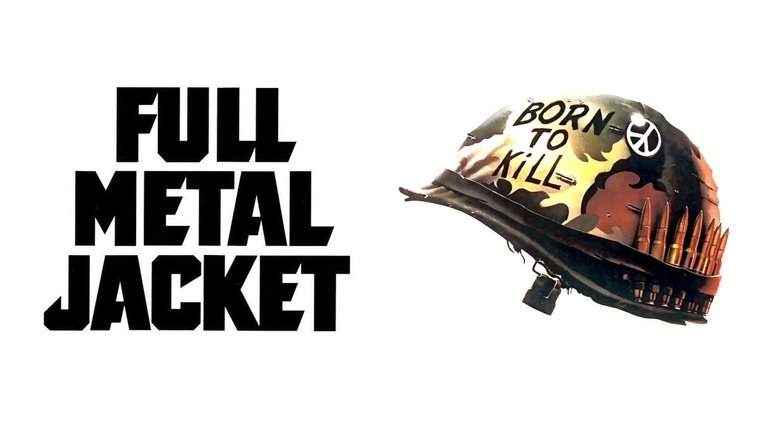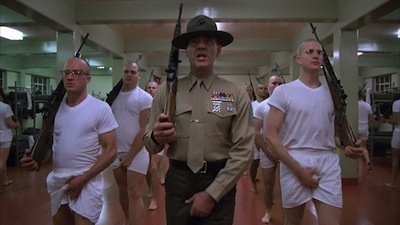← Back to Reviews

in
Director's Dissection
– FULL METAL JACKET –
Review
contains spoilers

A full metal jacket bullet is a small-arms projectile
consisting of a soft core encased in a shell of harder metal.
In many ways, this explanation of the bullet behind the title totally encapsulate the experience that the Marine Corps depicted in the film goes through and can be used as our first bullet point here. Behind the façade there is a human being, who during military training is physically broken down and manipulated with, until his outer shell is tough enough not to break upon the great impact of WAR.
‘Full Metal Jacket’ is one of the greatest anti-war films ever made in my opinion. It a isn’t perfect film, but the depiction of these young boys going through boot camp and busting their asses only to bite the dust in the act of war is amusing and alarming at the same time, especially in the way that it is executed and presented. R. Lee Ermey is amazingly convincing and creatively brilliant as the loud-mouthed and verbally abusing a-hole, who plays the sergeant and runs this recklessness as he pleases. He truly puts on a one-man show and even when push comes to shove, he doesn’t shiver and continues his behavior until it ends with his own demise. Dedicated and a true military hero, right?
The guy killing the sergeant, “Gomer Pyle”, is equally believable as the mentally challenged and socially awkward outsider, who doesn’t have a deep enough layer of toughness to survive the pressure from having to perform beyond what he is capable of. He is clearly unstable and isn’t able to simply bite the bullet and get on with it. He finally finds something he is good at tough, shooting riffles, and ends up literally biting the bullet in a horrifying scene also containing the signature “Kubrick stare” from Pyle. Joker, who was the guy assigned to help him, did do just that but also ended up betraying him the night when everyone beat up Pyle.
Joker is an interesting fellow, and like the joker from a deck of cards, isn’t really part of “the game” so to speak. There are 52 cards in a deck and 52 states in America. Well, that is after all a common mistake even for Americans but taking out the two jokers from the deck and there are suddenly 50 cards and it matches up. Where am I going with this again? Anyways, Joker does what is asked of him but usually not without a smart remark and he does question the things he is asked to do a lot, acting as the twisted moral voice in the midst of torn apart logic…
The second half of the film does indeed pale in comparison to the first, which showed us a side of war we hadn’t quite seen before. It was brutally expressive, mockingly morbid, purposely exaggerated and powerfully precise. I loved and loathed being on the verbal shooting range of sergeant Hartman as he slowly but surely turned these young boys into bareboned killer machines, and I equally found interest in seeing the different effects that war can have on you in the second part of the film. The second half might not be as exciting, but it is equally elaborate and expressive about the absurdity of war. The war we are presented with is big, brassy and bloated, filled with flashy imagery of false comfort and foolish masculinity inside a massively confusing and convoluted world of absolute chaos and dimwitted death-wishing’s. Everything is an act to survive the fact if you haven’t already turned mentally insane of course.
The pace drags a little more in the second half, especially towards the end, but after the coal-colored dark comedy on command, camaraderie, loyalty and whatnot, we end up in the final scene with the marines marching to the “Mickey Mouse March” also used earlier, sort of cementing the rather immature inanity of war as a concept, as well as the innocence in it and the façade that is necessarily placed on top of it all.
– FULL METAL JACKET –
Review
contains spoilers
A full metal jacket bullet is a small-arms projectile
consisting of a soft core encased in a shell of harder metal.
In many ways, this explanation of the bullet behind the title totally encapsulate the experience that the Marine Corps depicted in the film goes through and can be used as our first bullet point here. Behind the façade there is a human being, who during military training is physically broken down and manipulated with, until his outer shell is tough enough not to break upon the great impact of WAR.
‘Full Metal Jacket’ is one of the greatest anti-war films ever made in my opinion. It a isn’t perfect film, but the depiction of these young boys going through boot camp and busting their asses only to bite the dust in the act of war is amusing and alarming at the same time, especially in the way that it is executed and presented. R. Lee Ermey is amazingly convincing and creatively brilliant as the loud-mouthed and verbally abusing a-hole, who plays the sergeant and runs this recklessness as he pleases. He truly puts on a one-man show and even when push comes to shove, he doesn’t shiver and continues his behavior until it ends with his own demise. Dedicated and a true military hero, right?
The guy killing the sergeant, “Gomer Pyle”, is equally believable as the mentally challenged and socially awkward outsider, who doesn’t have a deep enough layer of toughness to survive the pressure from having to perform beyond what he is capable of. He is clearly unstable and isn’t able to simply bite the bullet and get on with it. He finally finds something he is good at tough, shooting riffles, and ends up literally biting the bullet in a horrifying scene also containing the signature “Kubrick stare” from Pyle. Joker, who was the guy assigned to help him, did do just that but also ended up betraying him the night when everyone beat up Pyle.
Joker is an interesting fellow, and like the joker from a deck of cards, isn’t really part of “the game” so to speak. There are 52 cards in a deck and 52 states in America. Well, that is after all a common mistake even for Americans but taking out the two jokers from the deck and there are suddenly 50 cards and it matches up. Where am I going with this again? Anyways, Joker does what is asked of him but usually not without a smart remark and he does question the things he is asked to do a lot, acting as the twisted moral voice in the midst of torn apart logic…
The second half of the film does indeed pale in comparison to the first, which showed us a side of war we hadn’t quite seen before. It was brutally expressive, mockingly morbid, purposely exaggerated and powerfully precise. I loved and loathed being on the verbal shooting range of sergeant Hartman as he slowly but surely turned these young boys into bareboned killer machines, and I equally found interest in seeing the different effects that war can have on you in the second part of the film. The second half might not be as exciting, but it is equally elaborate and expressive about the absurdity of war. The war we are presented with is big, brassy and bloated, filled with flashy imagery of false comfort and foolish masculinity inside a massively confusing and convoluted world of absolute chaos and dimwitted death-wishing’s. Everything is an act to survive the fact if you haven’t already turned mentally insane of course.
The pace drags a little more in the second half, especially towards the end, but after the coal-colored dark comedy on command, camaraderie, loyalty and whatnot, we end up in the final scene with the marines marching to the “Mickey Mouse March” also used earlier, sort of cementing the rather immature inanity of war as a concept, as well as the innocence in it and the façade that is necessarily placed on top of it all.
